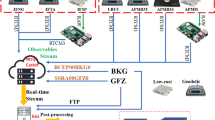Abstract
The paper offers solution to the problem of geostationary spacecraft navigation by navigation satellite signal measurements using nonlinear dynamic equations, which include perturbing factors such as non-sphericity of the gravitational field of the Earth, gravitational attraction of the Moon and the Sun, and direct solar radiation pressure. This solution uses the iterative Kalman filter based on UD-decomposition and is focused on the onboard implementation with limited computing resources. The estimates of current coordinates and velocity components obtained with the Kalman filter are taken into account when integrating nonlinear equations of a spacecraft motion up to the next solution time moment. With undetermined solar radiation pressure coefficient, the proposed solution proved efficient in terms of accuracy requirements for the spaceborne satellite navigation receiver. The tests were conducted using a GPS signal simulator and a receiver.
Similar content being viewed by others
References
Mikhaylov N.V., Mikhaylov, V.F., and Vasil’yev, M.V., Autonomous spacecraft navigation using GPS, Giroskopiya i Navigatsiya, 2008, no. 1, pp. 3–21.
Mikhaylov, N.V. and Chistyakov, V.V. Priemniki sputnikovoy navigatsii kosmicheskogo bazirovaniya: Arkhitektura i pervichnaya obrabotka signalov (Space-Based GNSS Receivers: Architecture and Primary Signal Processing), Voronezh: Nauchnaya kniga, 2014
Makhnenko, Yu.Yu., Economically effective technologies of navigation of geostationary satellites, Doctoral (Tech.) dissertation, Moskow, 2008.
Chernyavskii, G.M. and Bartenev, B.A., Orbity sputnikov svyazi (Orbits of communication satellites), Moscow: Svyaz’, 1978.
Bartenev, V.A., Malyshev, V.A., and Chernyavskii, G.M., Upravleniye orbitoy statsionarnogo sputnika (Control of stationary satellite control), Moscow: Mashinostroenie, 1984.
Lebedev, A.A., Bartenev, V.A., and Reshetnev, M.F., Upravleniye i navigatsiya ISZ na okolokrugovykh orbitakh (Control and navigation of Earth artificial satellites at near-circular orbits), Moscow: Mashinostroenie, 1988.
Montenbruck, O. and Gill, E., Satellite Orbits, Models, Methods and Applications, Berlin: Springer, 2000.
Makhnenko, Yu. Yu., Selection of motion model for navigation of geostationary satellite, Issledovano v Rossii, http://www.sci-journal.ru/articles/2008/092.pdf.
Global Positioning System: Theory and Applications, Parkinson, B.W., Spliker Jr, J.J., Eds., vol. I, II, 1996.
Coulson, P. and Srinivasan, B.J., New Techniques for Orbit Determination of Geosynchronous, Geosynchronous-Transfer, and Other High-Altitude Earth Orbiters, BEACON eSpace at Jet Propulsion Laboratory. 1997. http://hdl.handle.net/2014/22478
Mikhailov, N.V. and Vasil’ev, M.V., Autonomous satellite orbit determination using spaceborne GNSS receivers, Gyroscopy and Navigation, 2011, no. 1, pp. 1–9.
Islentev, I.E., Grechkoseev, A.K., and Kokorin, V.I., RF patent 2325667 C1, MPK, G01S 5/12 (2006.01), A method to determine the spacecraft state vector by the signals of space navigation systems, 27.05.2008 Byul. 15.
Tapley, V.D., Schutz, B.E., and Born, G.H., Statistical Orbit Determination, Elsevier Academic Press, 2004.
Mikhaylov, N.V. and Mikhaylov, V.F., A method to determine position and velocity of geostationary spacecraft using the measurements of satellite navigation systems, Uspekhi Sovremennoy Radioelektroniki, 2013, pp. 113–121.
Xu, G., Orbits, Berlin: Springer-Verlag, 2008.
Dmitriyev, S.P., Vysokotochnaya morskaya navigatsiya (High-precision marine navigation), St. Petersburg: Sudostroyeniye, 1991.
Stepanov, O.A., Primeneniye teorii nelineynoy fil’tratsii v zadachakh obrabotki navigatsionnoy informatsii (Applications of Nonlinear Filtering Theory to Navigation Data Processing), St. Petersburg: Elektropribor, 2003, 3rd edition.
Rivkin, S.S., Ivanovskii, R.Yu., and Kostrov, A.V., Statisticheskaya optimizatsiya navigatsionnykh sistem (Statistical optimization of navigation systems), Leningrad: Sudostroyeniye, 1976.
Bauer, F.H. et al., The GPS Space Service Volume, Proceedings of the 19th International Technical Meeting of the Satellite Division of The Institute of Navigation (ION GNSS 2006), Sept. 26–29, 2006, pp. 2503–2514.
Miller, J.J. and Moreau, M.C., Enabling a Fully Interoperable GNSS Space Service Volume, Presentations from 7th Meeting of the International Committee on Global Navigation Satellite Systems (ICG-7), Beijing, China, November 2012. http://www.gps.gov/multime-dia/presentations/2012/11/ICG/miller.pdf.
Dmitriev, S.P., Stepanov, O.A., and Pelevin, A.E., Motion control and non-invariant algorithms using the vehicle dynamics for inertial-satellite integrated navigation, 7th St. Petersburg International Conference on Integrated Navigation Systems, 29–31 May, 2000 St. Petersburg, Russia.
Stepanov, O.A., Osnovy teorii otsenivaniya s prilozheniyami k zadacham obrabotki navigatsionnoi informatsii (Foundations of Estimation Theory with Applications to Navigation Data Processing), Part 2. Introduction to Filtering Theory, St. Petersburg: Elektropribor, 2012.
Brown, R.G. and Hwang, P.Y.C., Introduction to Random Signals and Applied Kalman Filtering, New York: Wiley, 1992, 2nd edition.
Mikhailov, N.V., Avtonomanya navigatsiya kosmicheskikh apparatov pri pomotschi sputnikovykh radionavigatsionnykh sistem (Spacecraft Autonomous Navigation Using Satellite Radionavigation Systems), St. Petersburg, Politekhnika, 2014.
Author information
Authors and Affiliations
Corresponding author
Additional information
Published in Giroskopiya i Navigatsiya, 2014, No. 4, pp. 16–33.
Rights and permissions
About this article
Cite this article
Mikhaylov, N.V., Koshaev, D.A. Navigation solution for a geostationary satellite based on its dynamic equations and occasional GNSS measurements. Gyroscopy Navig. 6, 87–100 (2015). https://doi.org/10.1134/S207510871502008X
Received:
Published:
Issue Date:
DOI: https://doi.org/10.1134/S207510871502008X




